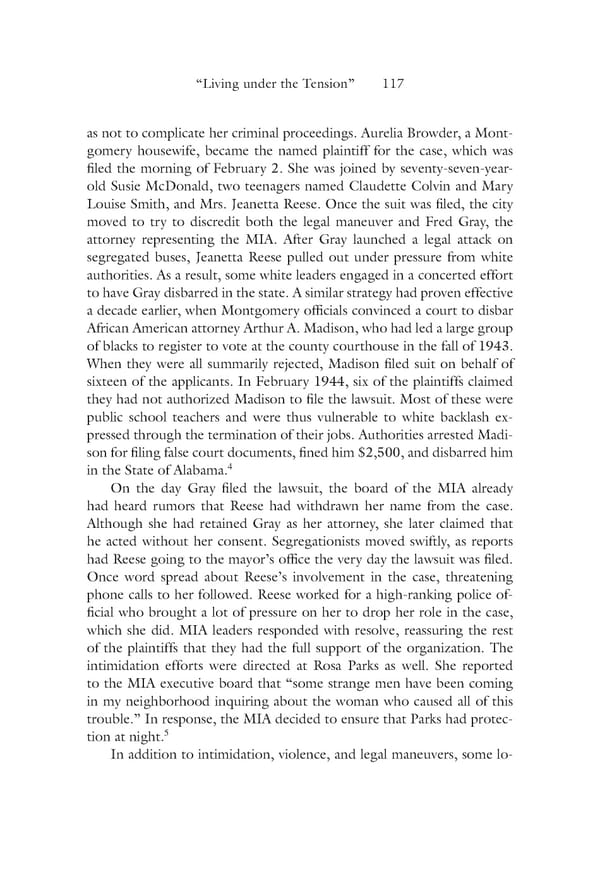“Living under the Tension” 117 as not to complicate her criminal proceedings. Aurelia Browder, a Mont- gomery housewife, became the named plaintiff for the case, which was filed the morning of February 2. She was joined by seventy-seven-year- old Susie McDonald, two teenagers named Claudette Colvin and Mary Louise Smith, and Mrs. Jeanetta Reese. Once the suit was filed, the city moved to try to discredit both the legal maneuver and Fred Gray, the attorney representing the MIA. After Gray launched a legal attack on segregated buses, Jeanetta Reese pulled out under pressure from white authorities. As a result, some white leaders engaged in a concerted effort to have Gray disbarred in the state. A similar strategy had proven effective a decade earlier, when Montgomery officials convinced a court to disbar African American attorney Arthur A. Madison, who had led a large group of blacks to register to vote at the county courthouse in the fall of 1943. When they were all summarily rejected, Madison filed suit on behalf of sixteen of the applicants. In February 1944, six of the plaintiffs claimed they had not authorized Madison to file the lawsuit. Most of these were public school teachers and were thus vulnerable to white backlash ex- pressed through the termination of their jobs. Authorities arrested Madi- son for filing false court documents, fined him $2,500, and disbarred him 4 in the State of Alabama. On the day Gray filed the lawsuit, the board of the MIA already had heard rumors that Reese had withdrawn her name from the case. Although she had retained Gray as her attorney, she later claimed that he acted without her consent. Segregationists moved swiftly, as reports had Reese going to the mayor’s office the very day the lawsuit was filed. Once word spread about Reese’s involvement in the case, threatening phone calls to her followed. Reese worked for a high-ranking police of- ficial who brought a lot of pressure on her to drop her role in the case, which she did. MIA leaders responded with resolve, reassuring the rest of the plaintiffs that they had the full support of the organization. The intimidation efforts were directed at Rosa Parks as well. She reported to the MIA executive board that “some strange men have been coming in my neighborhood inquiring about the woman who caused all of this trouble.” In response, the MIA decided to ensure that Parks had protec- 5 tion at night. In addition to intimidation, violence, and legal maneuvers, some lo-
 Becoming King: Martin Luther King Jr. Page 137 Page 139
Becoming King: Martin Luther King Jr. Page 137 Page 139